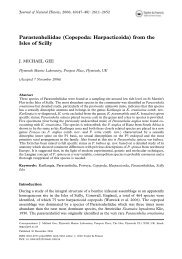An Updated Classification of the Recent Crustacea
An Updated Classification of the Recent Crustacea
An Updated Classification of the Recent Crustacea
Create successful ePaper yourself
Turn your PDF publications into a flip-book with our unique Google optimized e-Paper software.
otoidea on <strong>the</strong> recommendation <strong>of</strong> L. Holthuis<br />
(1993a:87, and pers. comm.).<br />
Superfamily Palaemonoidea<br />
The family Euryrhynchidae Holthuis, 1950, was<br />
added on <strong>the</strong> recommendation <strong>of</strong> Holthuis (pers.<br />
comm.). The family Kakaducarididae was described<br />
by A. J. Bruce (1993) as a subfamily <strong>of</strong> <strong>the</strong><br />
Palaeomonidae and is here treated as a family on<br />
<strong>the</strong> recommendation <strong>of</strong> L. Holthuis (pers. comm.).<br />
Superfamily Alpheoidea<br />
Authorship <strong>of</strong> <strong>the</strong> family Ogyrididae remains credited<br />
to Holthuis (1955). Although Hay and Shore<br />
(1918) established <strong>the</strong> family Ogyridae, as noted by<br />
M. Tavares (pers. comm.), L. Holthuis (pers.<br />
comm.) points out that <strong>the</strong>y based it on <strong>the</strong> type<br />
genus Ogyris Stimpson, 1860, which is a junior<br />
homonym <strong>of</strong> Ogyris Westwood and is thus invalid.<br />
Stebbing (1914) proposed <strong>the</strong> replacement genus<br />
Ogyrides, and thus <strong>the</strong> family name is Ogyrididae,<br />
first used as such by Holthuis (1955). We have not<br />
followed Christ<strong>of</strong>fersen’s (1987) suggestion to<br />
transfer <strong>the</strong> family Processidae to <strong>the</strong> Crangonoidea<br />
or to combine <strong>the</strong> alpheoids and crangonoids and<br />
pandaloids into one monophyletic taxon. Christ<strong>of</strong>fersen<br />
(1987) also proposed <strong>the</strong> new alpheoid families<br />
Nauticarididae (to contain Nauticaris and Saron),<br />
Alopidae (to contain Chorismus, Alope, and<br />
Caridion), and Bythocarididae (to contain Bythocaris,<br />
Cryptocheles, and Bathyhippolyte). We have<br />
not followed <strong>the</strong>se suggestions, nor have we recognized<br />
<strong>the</strong> families Merhippolytidae and Thoridae<br />
recognized by Christ<strong>of</strong>fersen (e.g., Christ<strong>of</strong>fersen<br />
1998).<br />
Christ<strong>of</strong>fersen later (1987) also suggested <strong>the</strong> recognition<br />
<strong>of</strong> <strong>the</strong> family Barbouridae (spelling corrected<br />
to Barbouriidae by Christ<strong>of</strong>fersen, 1990), to<br />
include <strong>the</strong> genera Barbouria, Janicea, and Parhippolyte.<br />
In his review <strong>of</strong> caridean shrimps <strong>of</strong> <strong>the</strong> Albatross<br />
Philippine Expedition, Chace (1997), although<br />
finding ‘‘no clear evidence to support <strong>the</strong><br />
superfamilial categories suggested by Christ<strong>of</strong>fersen<br />
(1987),’’ found ‘‘considerable reason to endorse his<br />
[Christ<strong>of</strong>fersen’s] establishment <strong>of</strong> <strong>the</strong> Barbouriidae.’’<br />
Chace refrained from treating <strong>the</strong>se genera<br />
as Barbouriidae in that paper, but we have taken<br />
that step here and recognize <strong>the</strong> Barbouriidae. Inclusion<br />
<strong>of</strong> <strong>the</strong> family in <strong>the</strong> superfamily Alpheoida<br />
is because <strong>of</strong> <strong>the</strong> similarities to hippolytids (all three<br />
genera were formerly treated as members <strong>of</strong> <strong>the</strong><br />
Hippolytidae).<br />
Superfamily Crangonoidea<br />
As noted above, Christ<strong>of</strong>fersen (1987) proposed <strong>the</strong><br />
family Barbouriidae for <strong>the</strong> genera Barbouria, Janicea,<br />
and Parhippolyte and originally placed <strong>the</strong><br />
family in <strong>the</strong> superfamily Crangonoidea. We treat<br />
it here as a member <strong>of</strong> <strong>the</strong> Alpheoidea because <strong>of</strong><br />
<strong>the</strong> similarities to <strong>the</strong> alpheoid family Hippolytidae<br />
(see Chace, 1997:40).<br />
Superfamily Pandaloidea<br />
Christ<strong>of</strong>fersen (1989) suggested a new classification<br />
<strong>of</strong> this superfamily, wherein he proposed many significant<br />
changes. Three new families were proposed<br />
(Plesionikidae for <strong>the</strong> genus Plesionika, Heterocarpoididae<br />
for <strong>the</strong> genus Heterocarpoides, and Dorodoteidae<br />
for <strong>the</strong> genus Dorodotes). In addition,<br />
<strong>the</strong> family Physetocarididae was removed from its<br />
own superfamily and placed in <strong>the</strong> Pandaloidea,<br />
and <strong>the</strong> family Heterocarpidae was recognized. No<br />
diagnoses <strong>of</strong> <strong>the</strong> new taxa were provided (although<br />
character states were given), and we have opted to<br />
not recognize <strong>the</strong>se changes for now.<br />
INFRAORDER ASTACIDEA<br />
Although we are not recognizing <strong>the</strong> ‘‘Macrura<br />
Reptantia’’ as a suborder (see above), for <strong>the</strong> most<br />
part, we have followed <strong>the</strong> admittedly conservative<br />
classification <strong>of</strong> Holthuis (1991) for <strong>the</strong> superfamilies<br />
and families <strong>of</strong> <strong>the</strong> Astacidea (see also Williams,<br />
1988, for classification <strong>of</strong> commercially important<br />
lobster families). Holthuis, who was at <strong>the</strong><br />
time dealing only with <strong>the</strong> marine lobsters and so<br />
did not include <strong>the</strong> parastacoids and astacoids,<br />
treated marine astacideans as belonging to a single<br />
superfamily Nephropoidea containing two families,<br />
Thaumastochelidae and Nephropidae. Our classification<br />
differs only in <strong>the</strong> inclusion <strong>of</strong> <strong>the</strong> Enoplometopoidea<br />
(see below) and Gylpheoidea, <strong>the</strong> latter<br />
placed by Holthuis among <strong>the</strong> infraorder Palinura<br />
(his Palinuridea). Scholtz (1999) recently reviewed<br />
<strong>the</strong> freshwater crayfishes (Astacoidea and Parastacoidea)<br />
and argued that <strong>the</strong>y are members <strong>of</strong> a distinct<br />
clade, Astacida, that is not closely related to<br />
clawed lobsters. However, strong molecular evidence<br />
suggests that clawed lobsters are indeed <strong>the</strong><br />
sister group to <strong>the</strong> astacids (Crandall et al., 2000).<br />
Superfamily Glypheoidea<br />
The primitive family Glypheidae (<strong>the</strong> only extant<br />
family in <strong>the</strong> Glypheoidea) has been transferred to<br />
<strong>the</strong> Astacidea as per <strong>the</strong> recommendations <strong>of</strong> Forest<br />
and Saint Laurent (1989). The taxon name, credited<br />
to Zittel in Bowman and Abele (1982), has<br />
now been credited to <strong>the</strong> earlier usage by Winckler<br />
(M. Hendrickx, pers. comm.), following <strong>the</strong> usage<br />
in Glaessner (1969).<br />
Superfamily Enoplometopoidea<br />
The genus Enoplometopus was assigned its own superfamily<br />
and family (Enoplometopoidea, Enoplometopidae)<br />
by Saint Laurent (1988).<br />
Superfamily Nephropoidea<br />
Tshudy and Babcock (1997) examined fossil and<br />
extant clawed lobsters and indicated that <strong>the</strong> family<br />
Thaumastochelidae, at least as used previously,<br />
may be paraphyletic. We have not taken <strong>the</strong> extra<br />
step <strong>of</strong> deleting this family (which would result in<br />
46 Contributions in Science, Number 39 Rationale











